Paulwanchez750
On this page, you find all documents, package deals, and flashcards offered by seller paulwanchez750.
- 145
- 0
- 0
Community
- Followers
- Following
145 items
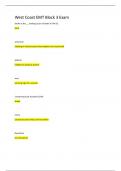
West Coast EMT Block 3 Exam
Stroke is the __ leading cause of death in the US. third aneurysm swelling of a blood vessel that weakens the vessel wall aphasia inability to produce speech aura warning sign for a seizure
- Exam (elaborations)
- • 12 pages •
Stroke is the __ leading cause of death in the US. third aneurysm swelling of a blood vessel that weakens the vessel wall aphasia inability to produce speech aura warning sign for a seizure
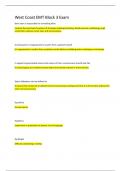
West Coast EMT Block 3 Exam
Brain stem is responsible for controlling what Controls the most basic functions of the body including breathing, blood pressure, swallowing, pupil constriction, balance, heart rate, and consciousness At what point is it appropriate to suction from a patients mouth It is appropriate to suction from a patients mouth before ventilating and or inserting an oral airway In regards to generalized seizures the nature of their consciousness should look like It should appear as an altered mental st...
- Exam (elaborations)
- • 19 pages •
Brain stem is responsible for controlling what Controls the most basic functions of the body including breathing, blood pressure, swallowing, pupil constriction, balance, heart rate, and consciousness At what point is it appropriate to suction from a patients mouth It is appropriate to suction from a patients mouth before ventilating and or inserting an oral airway In regards to generalized seizures the nature of their consciousness should look like It should appear as an altered mental st...
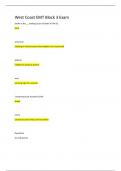
West Coast EMT Block 3 Exam
Stroke is the __ leading cause of death in the US. third aneurysm swelling of a blood vessel that weakens the vessel wall aphasia inability to produce speech aura warning sign for a seizure
- Exam (elaborations)
- • 12 pages •
Stroke is the __ leading cause of death in the US. third aneurysm swelling of a blood vessel that weakens the vessel wall aphasia inability to produce speech aura warning sign for a seizure
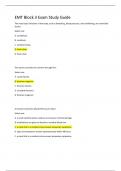
EMT Block 3 Exam Study Guide
The most basic functions of the body, such as breathing, blood pressure, and swallowing, are controlled by the: Select one: A. cerebellum. B. cerebrum. C. cerebral cortex. D. brain stem. D. brain stem. The spinal cord exits the cranium through the: Select one: A. cauda equina. B. foramen magnum. C. foramen lamina. D. vertebral foramen. B. foramen magnum.
- Exam (elaborations)
- • 38 pages •
The most basic functions of the body, such as breathing, blood pressure, and swallowing, are controlled by the: Select one: A. cerebellum. B. cerebrum. C. cerebral cortex. D. brain stem. D. brain stem. The spinal cord exits the cranium through the: Select one: A. cauda equina. B. foramen magnum. C. foramen lamina. D. vertebral foramen. B. foramen magnum.
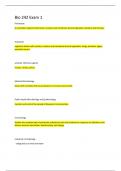
Bio 242 Exam 1
Prokaryote A unicellular organism that lacks a nucleus and membrane bound organelles. Bacteria and Archaea. Eukaryote organism whose cells contain a nucleus and membrane bound organelles. Fungi, protozoa, algea, parasatic worms, acellular infectious agents viruses, viroids, prions Medical Microbiology Deals with microbes that cause diseases in humans and animals Public Health Microbiology and Epidemiology monitor and control the spread of diseases in communities.
- Exam (elaborations)
- • 13 pages •
Prokaryote A unicellular organism that lacks a nucleus and membrane bound organelles. Bacteria and Archaea. Eukaryote organism whose cells contain a nucleus and membrane bound organelles. Fungi, protozoa, algea, parasatic worms, acellular infectious agents viruses, viroids, prions Medical Microbiology Deals with microbes that cause diseases in humans and animals Public Health Microbiology and Epidemiology monitor and control the spread of diseases in communities.
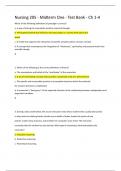
Nursing 205 - Midterm One - Test Bank - Ch 1-4
Which of the following definitions of paradigm is correct? a. A way of linking the naturalistic world to empirical thought b. Philosophical beliefs that influence the way people in a society think about the world c. A model that captures the interaction of specific variables within a known concept d. A concept that encompasses the integration of "wholeness," spirituality, and personal worth into scientific though B 2. Which of the following is the correct definition of theory? a. The ...
- Exam (elaborations)
- • 29 pages •
Which of the following definitions of paradigm is correct? a. A way of linking the naturalistic world to empirical thought b. Philosophical beliefs that influence the way people in a society think about the world c. A model that captures the interaction of specific variables within a known concept d. A concept that encompasses the integration of "wholeness," spirituality, and personal worth into scientific though B 2. Which of the following is the correct definition of theory? a. The ...
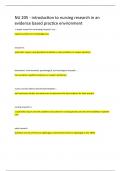
NU 205 - introduction to nursing research in an evidence based practice environment
`a major reason for condcuting research is to ... expand a professions knowledge base research is systematic inquiry using disciplined methods to solve problems or answer questions biomedical, environmental, psychological, and sociological research .... has resulted in significant advances in modern healthcare nurses must be able to discriminate between ... well conducted studies and weak ones to determine the best evidence for their practice
- Exam (elaborations)
- • 13 pages •
`a major reason for condcuting research is to ... expand a professions knowledge base research is systematic inquiry using disciplined methods to solve problems or answer questions biomedical, environmental, psychological, and sociological research .... has resulted in significant advances in modern healthcare nurses must be able to discriminate between ... well conducted studies and weak ones to determine the best evidence for their practice
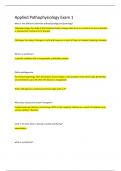
Applied Pathophysiology Exam 1
What is the difference between pathophysiology and pathology? Pathophysiology: the study of the functional bodily changes that occur as a result of an injury, disorder, or disease (the mechanisms of disease) Pathology: the study of changes in cells and tissues as a result of injury or disease (studying a disease) What is a syndrome? a specific condition with a recognizable, predictable pattern Define pathogenesis. the disease beginning; when the disease process begins until symptom onset ...
- Exam (elaborations)
- • 49 pages •
What is the difference between pathophysiology and pathology? Pathophysiology: the study of the functional bodily changes that occur as a result of an injury, disorder, or disease (the mechanisms of disease) Pathology: the study of changes in cells and tissues as a result of injury or disease (studying a disease) What is a syndrome? a specific condition with a recognizable, predictable pattern Define pathogenesis. the disease beginning; when the disease process begins until symptom onset ...
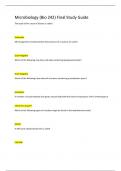
Microbiology (Bio 242) Final Study Guide
The study of the cause of disease is called Eukaryotic Microorganisms characterized by the presence of a nucleus are called Gram Negative Which of the following may have cell walls containing lipopolysaccharide? Gram Negative Which of the following have external structures containing a periplasmic space? Halophiles A member of euryarchaeota that grows around hydrothermal vents and produces CH4 is methanopyrus
- Exam (elaborations)
- • 11 pages •
The study of the cause of disease is called Eukaryotic Microorganisms characterized by the presence of a nucleus are called Gram Negative Which of the following may have cell walls containing lipopolysaccharide? Gram Negative Which of the following have external structures containing a periplasmic space? Halophiles A member of euryarchaeota that grows around hydrothermal vents and produces CH4 is methanopyrus
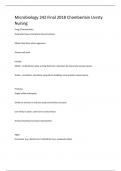
Microbiology 242 Final 2018 Chamberlain Uvrsty Nursng
Fungi Characteristics Eukaryotic (have membrane-bound nucleus) Obtain food from other organisms Possess cell walls Include: Molds—multicellular; grow as long filaments; reproduce by sexual and asexual spores Yeasts—unicellular; reproduce asexually by budding; some produce sexual spores. Protozoa Single-celled eukaryotes Similar to animals in nutrient needs and cellular structure Live freely in water; some live in animal hosts Asexual (mostly) and sexual reproduction Algae Unicel...
- Exam (elaborations)
- • 53 pages •
Fungi Characteristics Eukaryotic (have membrane-bound nucleus) Obtain food from other organisms Possess cell walls Include: Molds—multicellular; grow as long filaments; reproduce by sexual and asexual spores Yeasts—unicellular; reproduce asexually by budding; some produce sexual spores. Protozoa Single-celled eukaryotes Similar to animals in nutrient needs and cellular structure Live freely in water; some live in animal hosts Asexual (mostly) and sexual reproduction Algae Unicel...
